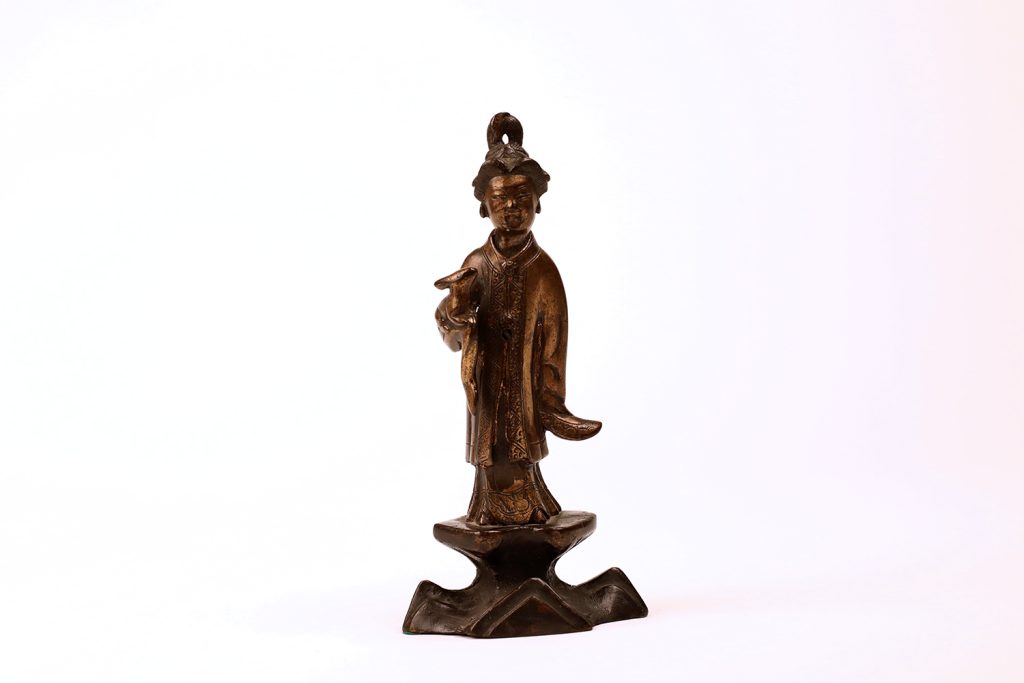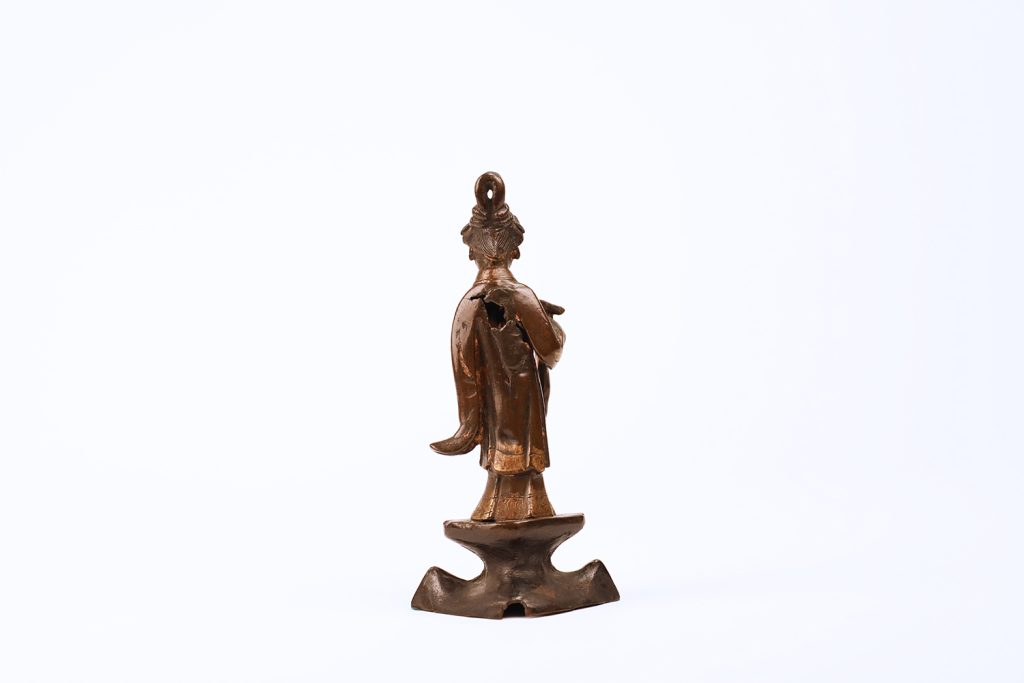Chang E, the Moon Goddess
Chang E, the Moon Goddess

Chang E, the Moon Goddess
c. 1600 (Ming Dynasty)
Bronze with gold plating
7 x 3.5 x 2.5 in.
China
2000.105
Made of bronze and gold plating, this statue depicts the goddess Cháng’é 嫦娥 in a flowing gown with long hair in a bun and a serene expression on her face, holding a rabbit. Barely visible via a rough opening in the back is a long, thin piece of wood, interred sometime after creation then poorly patched over.
First recorded in the Warring States period (481-221 BCE), Cháng’é is a figure in Chinese mythology known for her association with the Moon.1 The most well-known version of her story tells of her taking an elixir meant for her husband, the archer Hòu Yì 后裔, and ascending to the Moon, where she became the Moon Goddess in company with a rabbit.2 Due to the story’s compatibility with the rising Daoist idea of immortal gods, it was infiltrated by the immortal idea and the figure herself was deified in the Western Han dynasty (202 BCE-9 CE).3
The myth has constantly evolved throughout history. Han-dynasty representations usually depict Cháng’é as a divine beauty using features like billowing scarves and backgrounds of clouds or waves to signify the goddess’s celestial nature.4 During the Tang Dynasty (618-907 CE), Cháng’é was frequently used as a symbol of solitude and seclusion in literary works. During the Ming dynasty, the iconographical elements of the Moon Goddess’s immortality were less significant in the portrayal of Cháng’é. The portrayal of Cháng’é moved away from strictly religious or mythological depictions. In this period, she was often depicted in a more humanized and relatable manner. Her portrayal highlighted her beauty and grace rather than focusing solely on her divine status. Artists and writers of the time incorporated elements from everyday life and courtly culture, transforming the goddess into a more approachable and relatable figure.5 The exhibited sculpture potentially exemplifies this trend of artistic repression. The Moon Goddess’s broad-sleeved dress with circular collar and hairstyle much resemble what secular women, such as court ladies and courtesans, wore in the Ming dynasty.6

Buddhism and Daoism have coexisted in China since at least the start of the first century as seen from accounts of Emperor Ming’s (r. 58-75 CE) dream about the Buddha.7 Despite criticism from religious authorities, the intertwined trajectories of Buddhism and Daoism led many practitioners to blur the lines between the two religions.8 One such Buddhist practice adopted by Daoists is the use of fragrant wood for veneration. The use of fragrant wood is an integral part of Buddhist traditions and was sometimes used as a symbolic relic or ritual deposit.9 In this way, we can potentially view the bronze statue with interred wood as a visual depiction of the interaction of Buddhism and Daoism in Chinese culture. In Buddhist tradition, it is common to place relics inside statuary as a way to enliven the object.10 Similar to how Cháng’é achieved her immortality through a potion, the deposition of wood may likewise act as a path to eternal life. Thus, while this object is perhaps not connected to Buddhist relic practice at first glance or even a relic in the traditional sense, its unique artistic intervention may reflect the influence of the Buddhist relic and image making by the time of its creation in and after seventeenth century.
Thomas Kalmer
Chemical Biology
Class of 2023
Yuyang Zou
Economics and History of Art
Class of 2023
Annotated Bibliography
Kim, Youn-mi. “Surrogate Body inside the Sacred Body: Used Clothing in Korean Buddhist Statues.” Cahiers d’Extrême-Asie 28 (2019): 101–32.
If you would like to better understand object placement in Buddhist relics, look to Kim, Youn-mi “Surrogate Body…” In this article, Kim details the story of King Sejo, his rise to power, his supposed encounter with the Buddha, and how that story influenced and was interpreted in the context of a unique object in a Buddhist relic. Youn-mi’s exploration is compelling and revealing. It is a must-read for anyone interested in the interplay of relics, politics, and Buddhism.
Pan, Yanlin. “Paradigm Shifts, Iconographic Changes: The Moon Goddess Chang’e and Other Beauties in Paintings of the Mid Ming.” ProQuest Dissertations Publishing, 2013.
Poceski, Mario. “Chapter 2, Buddhism in Chinese History” in The Wiley Blackwell Companion to East and Inner Asian Buddhism, ed. Mario Poceski, 40-62. John Wiley & Sons, 2014.
Mario Pocesky is a professor of Buddhist Studies and Chinese religions at the University of Florida. One of his many published works is the Wiley Blackwell Companion to East and Inner Asian Buddhism. The Wiley Blackwell Companion to East and Inner Asian Buddhism describes the introduction, spread, and impact of Buddhism in China. For those interested in the Influence and spread of Buddhism in Chinese history, the Wiley Blackwell Companion to East and Inner Asian Buddhism is the place to look.
Ren, Meng, et al. “Characterization of the Incense Sacrificed to the Sarira of Sakyamuni from Famen Royal Temple during the Ninth Century in China.” Proceedings of the National Academy of Sciences, vol. 119, no. 21 (2022): 1-10. https://doi.org/10.1073/pnas.2112724119.
Wang, Eugene Y. “Mirror, Moon, and Memory in Eighth-Century China: From Dragon Pond to Lunar Palace.” Cleveland Studies in the History of Art 9 (2005): 42–67. https://doi.org/10.1484/J.CSHAC.2.301911.
For more information on the mythology of Chang’e and worship of Chang’e, the audience can check out “Mirror, Moon, and Memory in Eighth-Century China” by Eugene Y. Wang. Wang is a scholar in early Chinese art and archaeology at Harvard University. He is also involved in projects on Asian Buddhist sites. This article explores the significance of images of the moon and mirrors. In this specific article, Wang discusses the symbolism of the moon and the mythology of Chang’e, which became the source of inspiration in Chinese literature and art. This would help the viewer form a deeper understanding of the significance of the moon and the legend of Chang’e in Chinese culture.
Zhao, Hong 赵红. “道教神仙信仰影响下的嫦娥奔月神话之演变 [Evolvement of the Myth of Chang’e’s flying to the Moon under the Influence of Taoism].” Journal of South-Central University for Nationalities. Humanities and Social Science 27, no. 4 (2007): 164–67.
